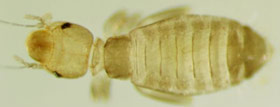Booklice, Psocids (Psocoptera)

Booklouse. USDA ARS.
IPM Steps to Reduce Booklice
1. Sample for Pest
Where to find it while inspecting: Booklice prefer warmth and moisture because they feed on microscopic molds in books, cardboard, packaging, rugs and even in stored grains.
2. Proper ID
Size and Particulars: Booklice are flat, pale (yellowish or grayish), wingless with an overall long body shape but only 1–4 mm long. Eggs are difficult to see because of size and color (white ovals) and because they are often covered with minuscule debris. Life cycles take 4–8 weeks on average, depending on conditions, with no relevance to time of year (though they prefer humidity).
3. Learn the Pest Biology
Life Cycle: Adult females lay eggs near food source; eggs hatch within a few days.
Preferred Food Sources: Molds found in organic matter such as paper and grains.
Preferred Habitat: Most often paper products in moist areas; occasionally rugs, upholstered furniture (with natural fiber stuffing) and sometimes around plaster walls that have been slow to dry.
4. Determine Threshold
Threshold: Because of their size, you will often not see them until there is damage, at which point you will need to act.
5. Choose Tactics
Best Management Practices: Reduce moisture with air flow. Act to keep humidity under 50%. Remove any obvious habitat source—infested books, cardboard and furniture. (Thorough drying/dehydration should end infestation.)
Treatment Methods: Reduce humidity, correct sources that lead to excessive moisture indoors. Aim to remove food source—mold. Pesticide use is rarely needed or effective.
6. Evaluate
Was the tactic successful? Record the date pests were first noted, and the tactic you used, and its success. Use one of our RECORD KEEPING tools.
For More Information
Penn State Entomological Notes: Book Lice
Utah State University: Booklice and Their Relatives
Remember:
When a pesticide application is necessary, all necessary and required precautions are taken to minimize risk to people and the environment and to minimize risk of pesticide resistance or pest resurgence. Pesticide use in your school may be prohibited or regulated by local policies or state and federal regulations. Risk reduction methods can include, but are not limited to, spot-treatment, the use of gel or paste bait formulations placed in inaccessible locations, injection into a crack or crevice, and other methods that reduce potential exposure.